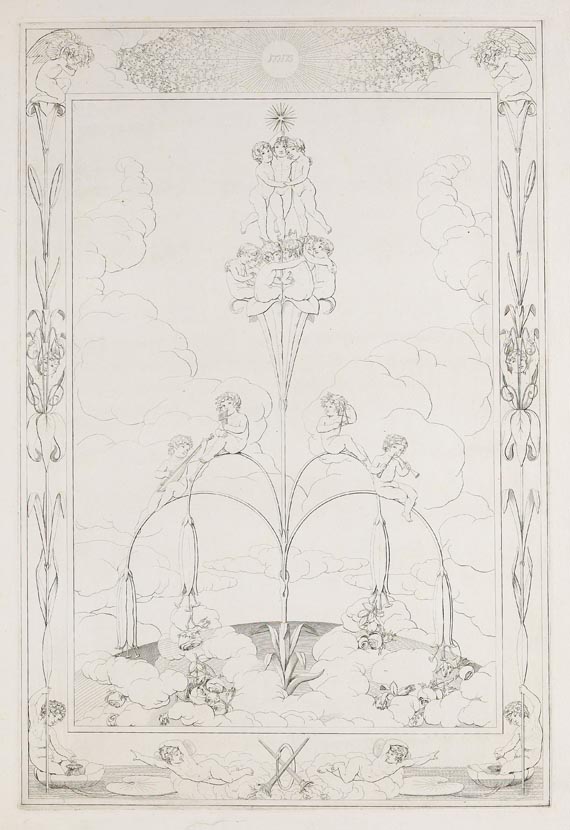Dictionary


French Romanticism
Romantic tendencies in French painting can be found later than in Germany, even though atmospheric-classicist and romantic elements can be observed in classicist works by Pierre-Paul Prud'hon, however, Classicism had only been overcome with the salon exhibition in 1827.
Along with Antoine-Jean Gros and Théodore Chassériau, other masters of French Romanticism are Théodore Géricault (1791-1824) and Eugène Delacroix (1798-1863). Works by both artists show a favor for historic images, whereas French Romanticism greatly differs from other European countries and their predominant liking for landscapes.
Pictures by Géricault and Delacroix are characterized by an exuberant pictorial abundance, a vivacious flow, luscious colors, defined chiaroscuro and a figure and space constellation that is difficult to overlook at first sight. Both artists visualize their subjects in a highly dramatic manner.
Géricault's "Floß der Medusa" (Medusa's Float) from 1818-19 greatly inspired the younger Delacroix. His oeuvre comprises mythological themes such as the "Dantebarke" (1822), being his first success, and current events, such as the street battles in the course of the July Revolution in 1830, which inspired the painting "Die Freiheit führt das Volk an" (Freedom is leading the people), made in 1830. Oriental subjects, which he encountered on a journey to Morocco in 1832, were another source of inspiration for Delacroix. Their exotic attraction is depicted in "Tod des Sardanapal" (Death of Sardanapal) from 1827-28 or in sensual harem scenes. Delacroix' masterly colouring, which is geared at Rubens, is also worthwhile mentioning, adding a certain charm by means of color shades and a bold complementary contrast.
Even though the heyday of French Romanticism had been reached with Géricault and Delacroix, last hints of Romanticism can still be found in works by Gustave Doré (1832-83) or by representatives of the Barbizon school.
Romantic tendencies in French painting can be found later than in Germany, even though atmospheric-classicist and romantic elements can be observed in classicist works by Pierre-Paul Prud'hon, however, Classicism had only been overcome with the salon exhibition in 1827.
Along with Antoine-Jean Gros and Théodore Chassériau, other masters of French Romanticism are Théodore Géricault (1791-1824) and Eugène Delacroix (1798-1863). Works by both artists show a favor for historic images, whereas French Romanticism greatly differs from other European countries and their predominant liking for landscapes.
Pictures by Géricault and Delacroix are characterized by an exuberant pictorial abundance, a vivacious flow, luscious colors, defined chiaroscuro and a figure and space constellation that is difficult to overlook at first sight. Both artists visualize their subjects in a highly dramatic manner.
Géricault's "Floß der Medusa" (Medusa's Float) from 1818-19 greatly inspired the younger Delacroix. His oeuvre comprises mythological themes such as the "Dantebarke" (1822), being his first success, and current events, such as the street battles in the course of the July Revolution in 1830, which inspired the painting "Die Freiheit führt das Volk an" (Freedom is leading the people), made in 1830. Oriental subjects, which he encountered on a journey to Morocco in 1832, were another source of inspiration for Delacroix. Their exotic attraction is depicted in "Tod des Sardanapal" (Death of Sardanapal) from 1827-28 or in sensual harem scenes. Delacroix' masterly colouring, which is geared at Rubens, is also worthwhile mentioning, adding a certain charm by means of color shades and a bold complementary contrast.
Even though the heyday of French Romanticism had been reached with Géricault and Delacroix, last hints of Romanticism can still be found in works by Gustave Doré (1832-83) or by representatives of the Barbizon school.
Offers
Headquarters
Joseph-Wild-Str. 18
81829 Munich
Phone: +49 89 55 244-0
Fax: +49 89 55 244-177
info@kettererkunst.de
Louisa von Saucken / Undine Schleifer
Holstenwall 5
20355 Hamburg
Phone: +49 40 37 49 61-0
Fax: +49 40 37 49 61-66
infohamburg@kettererkunst.de
Dr. Simone Wiechers / Nane Schlage
Fasanenstr. 70
10719 Berlin
Phone: +49 30 88 67 53-63
Fax: +49 30 88 67 56-43
infoberlin@kettererkunst.de
Cordula Lichtenberg
Gertrudenstraße 24-28
50667 Cologne
Phone: +49 221 510 908-15
infokoeln@kettererkunst.de
Hessen
Rhineland-Palatinate
Miriam Heß
Phone: +49 62 21 58 80-038
Fax: +49 62 21 58 80-595
infoheidelberg@kettererkunst.de
We will inform you in time.




